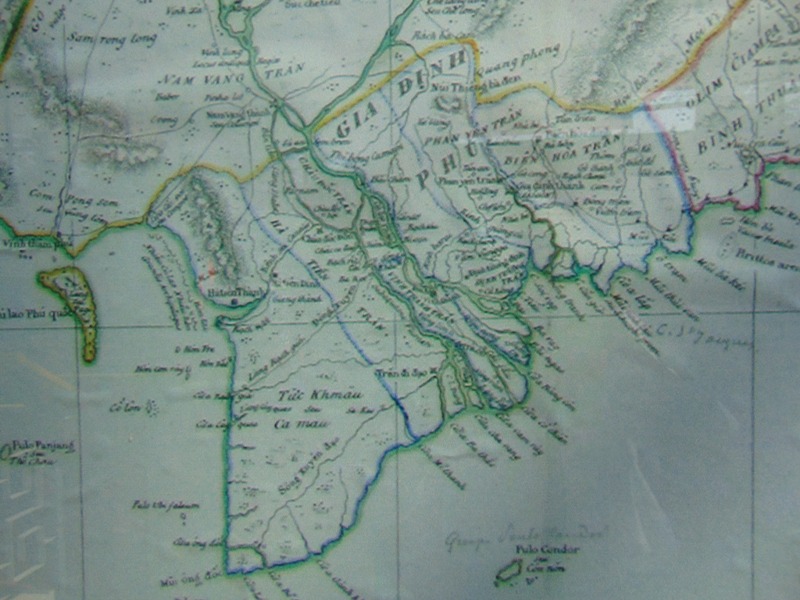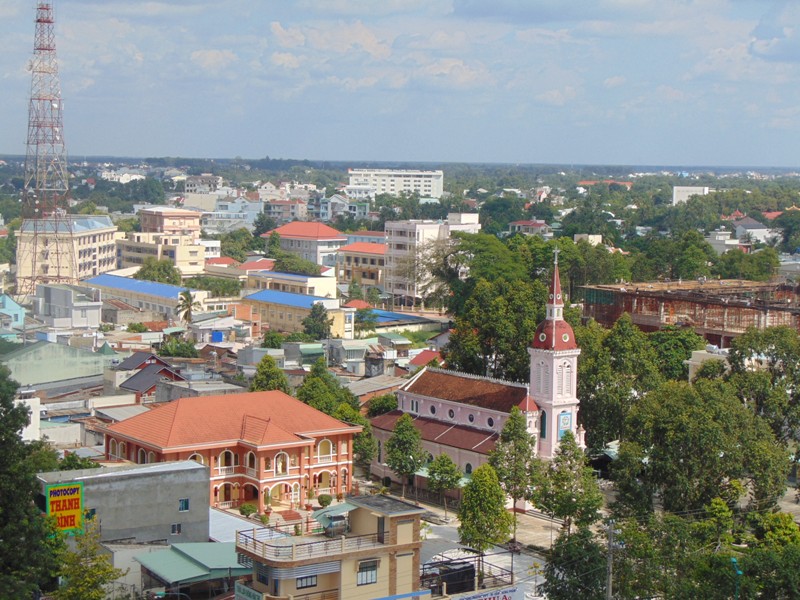In the winter of October of the year of the Pig (1799), after recovering most of Gia Dinh land, Nguyen Anh (Lord Nguyen Phuc Anh, the penultimate Nguyen Lord) rearranged the administrative and defense units, established Quang Phong Dao in the area of present-day Tay Ninh, under Phien Tran citadel. Quang Phong Dao's office was located in Cam Giang village (in present-day Tay Ninh land). Dai Nam Thuc Luc (pre-edition) of the National History Institute of the Nguyen Dynasty recorded: "The seventh year of Mau Dan (1698), in the spring... The Lord (Nguyen Phuc Chu) began to establish Gia Dinh citadel. Lord Nguyen Phuc Chu ordered Commander Nguyen Huu Canh to inspect the land of Chan Lap, divided the land of Dong Pho, took Dong Nai land as Phuoc Long district, established Tran Bien citadel, took Saigon land as Tan Binh district, established Phien Tran citadel.
Dai Nam Thuc Luc (pre-edition) of the National History Institute of the Nguyen Dynasty recorded: “The seventh year of Mau Dan (1698), spring… The Lord (Nguyen Phuc Chu) began to establish Gia Dinh prefecture.
Lord Nguyen Phuc Chu sent Commander Nguyen Huu Canh to inspect the land of Cambodia, divide the land of Dong Pho, take Dong Nai land as Phuoc Long district, build Tran Bien citadel, take Saigon land as Tan Binh district, build Phien Tran citadel.
Each dinh had the positions of governor, chief of the register, scribe, and the elite and subordinate soldiers, naval and land forces..." Tay Ninh land at that time belonged to Tan Binh district.
By 1757, the establishment of the new land's boundaries (today's Southern region) was basically completed. Vietnamese people from the lowlands came to Tay Ninh to reclaim land and establish settlements in increasing numbers, especially after the Tay Son army drove out the Nguyen Anh army, and war broke out continuously throughout the citadels and towns in the Gia Dinh plain.
In October of the winter of the year Ky Hoi (1799), after recovering most of Gia Dinh land, Nguyen Anh rearranged administrative and defense units, establishing Quang Phong Dao in the area of Tay Ninh today, under Phien Tran palace.
The Taoist temple was located in Cam Giang village. Several villages were also established such as: Cam Giang Tay, Thanh Duc, Thanh Phuoc, Binh Phu, Binh Tinh (now An Tinh). That was the first administrative organization in Tay Ninh.
Dao is a rather special administrative unit and is not required (must exist) in the administrative system of the Nguyen Dynasty.
The head of the Dao is the Dao Quan, whose main responsibility is to maintain national security and defense. Therefore, after ascending the throne, the villages of Quang Phong Dao were placed under Binh Cach commune, Thuan An district, Tan Binh prefecture. At this time, Gia Dinh prefecture had become Phien An town, managing one prefecture, four districts, and eight communes.

The map of An Nam Dai Quoc drawn by Bishop Jean Louis Taberd in 1838 has Quang Phong parish and Chieng Mountain (Ba Den, Tay Ninh province today).
In the spring of the 17th year of Minh Mang (1836), the royal court launched an inspection tour of the South led by two high-ranking mandarins, Truong Dang Que and Truong Minh Giang.
One of the two objectives of this inspection was to measure the reclaimed land throughout the new land. In the fall of that year (1836), based on the inspection results, the court established Tay Ninh prefecture. The prefecture was located northwest of Gia Dinh citadel.
To the north, it borders the border of Chenla. To the south, it borders Binh Duong district, Tan Binh prefecture and Cuu An district, Tan An prefecture. To the east, it borders Binh Long district, Tan Binh prefecture. To the west, it borders Chenla.
Tay Ninh Prefecture has two districts, Tan Ninh and Quang Hoa. The capital is located in the present-day Tay Ninh City. In 1838, the citadel was built at the location of the present-day Provincial Military Command. The prefecture also manages (directly governs) Tan Ninh District. Quang Hoa District Citadel is located in Cam Giang village, on the old Quang Hoa citadel (since 1824).
In this detail, both the author of the book “Dai Nam Nhat Thong Chi” and the author Nguyen Dinh Tu (Tay Ninh past and present, Xua Nay Magazine No. 96, 2001) were mistaken. That detail is: “Quang Hoa district is located 29 miles (about 16 km) northwest of the prefecture”. The distance is correct but the direction is wrong. In fact, Quang Hoa district (currently Cam Giang) is located in the opposite direction, that is, southeast of the prefecture.
During the French colonial period, after the Nham Tuat Treaty (1862), on August 12, the colonial government re-established Tay Ninh prefecture. The prefecture included 3 districts: Tan Ninh, Quang Hoa, and Binh Long.
Previously, Binh Long belonged to Tan Binh district. Tan Ninh district consisted of 3 cantons: Hoa Ninh, Ham Ninh, My Ninh with 27 villages. Quang Hoa district consisted of 2 cantons: Triem Hoa, Giai Hoa with 26 villages. On February 3, 1866, the French government dissolved Tan Ninh and Quang Hoa districts to establish two Inspectorates of Tay Ninh and Quang Hoa. Binh Long district was dissolved and merged into the Saigon Inspectorate.
August 16, 1867, Quang Hoa Inspectorate was changed to Trang Bang Inspectorate. The governing apparatus was also moved to Gia Loc village.
June 5, 1871, Trang Bang Inspectorate was dissolved, merged with Tay Ninh Inspectorate, becoming a new administrative unit called Tay Ninh Inspectorate.
On December 20, 1899, the Governor-General of Indochina issued a decree that from January 1, 1900, all the Tham Bien districts in Cochinchina were changed to provinces. The administrative unit of Tay Ninh province has existed since then until today (according to Vuong Cong Duc in “Trang Bang Phuong Chi”. According to Nguyen Dinh Tu, he wrote the Inspectorate Departments as Inspectorate Departments; and the Tham Bien Districts as Tham Bien Departments).
In 1903, the French established Trang Bang district including 4 communes: Ham Ninh Ha (6 villages), My Ninh (5 villages), Triem Hoa (5 villages) and Giai Hoa (6 villages).
In 1930, Thai Binh district was established, including 7 communes: Hoa Ninh (9 villages), Ham Ninh Thuong (4 villages), Giai Hoa (6 villages) transferred from Trang Bang district, Khan Xuyen (5 villages), Bang Chrum (2 villages); Tabel Jul (3 villages) and Chon Ba Den (4 villages). In 1942, Thai Binh district was renamed Chau Thanh.
In 1948, the government established Go Dau Ha district, then dissolved it (September 1954), then re-established it (March 1955). Until January 1957, the administrative units of Tay Ninh province included 3 districts: Chau Thanh (6 cantons, 29 communes), Go Dau Ha (3 cantons, 16 communes), Trang Bang (1 canton, 7 communes).
In April 1959, Chau Thanh district was divided into two districts: Phuoc Ninh and Phu Khuong. In May 1959, Go Dau Ha and Trang Bang districts were renamed into two new districts: Hieu Thien and Khiem Hanh. In July 1961, Khiem Hanh district was separated and Phu Duc district was established.
In October 1963, Phu Duc district (Trang Bang) was separated into Hau Nghia province, and its old name was changed to Trang Bang. In 1965, the canton level was abolished; before 1975, Tay Ninh had 45 communes in 4 districts: Hieu Thien, Khiem Hanh, Phu Khuong and Phuoc Ninh.
On the revolutionary government side, since the Southern resistance on September 23, 1945, the revolutionary government (still existing in parallel with the pro-French and pro-American governments) abolished the district and canton levels. On the regional scale, in 1951, the Southern Regional Party Committee merged a number of districts of Gia Dinh and Cho Lon provinces into Tay Ninh to form Gia Dinh Ninh province.

Tay Ninh city, Tay Ninh province today.
In May 1951, Duong Minh Chau base district was established, including 5 communes, with a population of about 10,000 people.
In 1950, Tay Ninh town was established on the basis of communes in the provincial capital area. Some communes in Trang Bang and Chau Thanh districts were also merged into inter-commune such as: Don Thuan Loi (from Don Thuan and Thuan Loi), Hao Duoc, Hoa Hoi, Thai Binh into Duoc Hoa Binh commune.
In October 1954, the Eastern Inter-Zone Committee decided to separate Tay Ninh back according to the old boundary.
In 1956, the area of communes in the Tay Ninh Holy See with many Cao Dai followers was established as a district called Toa Thanh district; at one point this district merged with Duong Minh Chau district but in March 1961 it was separated, officially establishing Toa Thanh district including 4 communes: Truong Hoa, Ninh Thanh, Long Thanh and Hiep Ninh.
Also in 1961, Ben Cau Executive Committee was established and by early 1962, Ben Cau district was officially added. And Go Dau district was separated from Trang Bang.
From then on, the revolutionary government had 5 districts and one town including: Trang Bang, Go Dau, Ben Cau, Duong Minh Chau, Toa Thanh and Tay Ninh town. By June 1972, Tan Bien district was established including 5 communes: Hoa Hiep, Soc Thiet, Mo Cong, Ka Tum and Tan Hung.
After April 30, 1975, the administrative apparatus of Tay Ninh province was reorganized. Toa Thanh district was named after the old district, Phu Khuong district, and on March 14, 1979, it was renamed Hoa Thanh. The whole province had one town and 7 districts, 68 communes, wards and towns. On May 13, 1989, the new district of Tan Chau was established (separated from the 2 districts of Tan Bien and Duong Minh Chau).
In 2016, Tay Ninh continued to build and when necessary, established new communes. Up to now, there is one city (type 3 urban area), 8 districts, including 6 towns (type 5 urban areas) and two towns have just been recognized as type 4 urban areas as a premise to upgrade two districts to towns. The process of changing administrative units, more specifically when the opportunity arises, will be requested again.
NGUYEN QUANG VAN (Collected from history books about Tay Ninh, from the Nguyen Dynasty to the present) (Tay Ninh Newspaper)
Source: https://danviet.vn/dia-danh-bien-dong-thoi-nha-nguyen-vi-sao-tinh-tay-ninh-xua-nam-trong-mot-huyen-cua-sai-gon-20250321102421036.htm




![[Photo] Anh Hoang - Dinh Duc successfully defended the men's doubles championship of the National Table Tennis Championship of Nhan Dan Newspaper](https://vphoto.vietnam.vn/thumb/1200x675/vietnam/resource/IMAGE/2025/5/23/d6ab3bcac02c49928b38c729d795cac6)
![[Photo] Top players gather at the 2025 Nhan Dan Newspaper National Table Tennis Championship](https://vphoto.vietnam.vn/thumb/1200x675/vietnam/resource/IMAGE/2025/5/23/9ad5f6f4faf146b08335e5c446edb107)
























































































Comment (0)